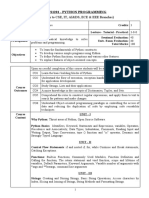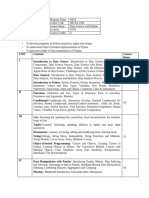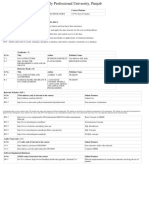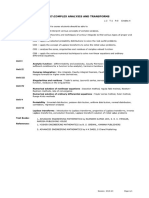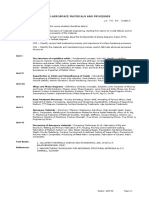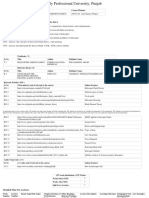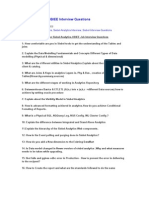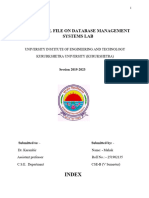Spython
Uploaded by
Yashwanth Krishna GampaSpython
Uploaded by
Yashwanth Krishna GampaINT102:COMPUTER PROGRAMMING-I
L:0 T:0 P:4 Credits:2
Course Outcomes: Through this course students should be able to
CO1 :: observe real life situational problems and think creatively about solutions of them.
CO2 :: apply a solution clearly and accurately in a program using Python.
CO3 :: develop advanced data science concepts using machine learning approach to programs.
CO4 :: visualize data for creating informative and attractive statistical graphics in python.
Unit I
Introduction : python programming language, introduction to programs and debugging, formal and
natural language
Variables, Expressions and Statements : values, variables, variables name and keywords,
statements, operators and operand, order of operations, operations on string, composition and
comments
Conditionals and Iteration : modulus operator, boolean expressions, logic operators, conditional ,
alternative execution, nested conditionals and return statements, while statements, encapsulation and
generalization
Unit II
Functions and recursion : function calls, type conversion and coercion, math functions, adding new
function, parameters and argument, recursion and its use
String and Regular Expressions : string a compound data type, length, string traversal, string
slices, comparison, find function, looping and counting
Unit III
Lists : list values, length, membership, operations, slices, deletion, accessing elements, list and for
loops, list parameters and nested list
Tuples and Dictionaries : mutability and tuples, tuple assignment, tuple as return values, random
numbers and list of random numbers, counting and many buckets, dictionaries operations and
methods, sparse matrices ,aliasing and coping
Files and exceptions : text files, binary files, standard Input Output and errors, writing variables ,
directories, pickling, exceptions, glossary
Unit IV
Creating and Manipulating Numerical Data : arrays, creating arrays, basic data types, indexing
and slicing, copies and views, numerical operations on array
Unit V
Classes and objects : creating classes, creating instance objects, accessing attributes, overview of
OOP terminology
Object oriented programming terminology : class inheritance, overriding methods, data hiding,
function overloading
Unit VI
Divide and Conquer technique : introduction to divide and conquer technique, binary search, quick
sort, merge sort
Graph optimization technique : introduction to graph optimization technique, depth first search,
breadth first search, problem solving using graph optimization techniques
Text Books:
1. NTRODUCTION TO COMPUTATION AND PROGRAMMING USING PYTHON by GUTTAG, JOHN
V, MIT Press
2. PROGRAMMING AND PROBLEM SOLVING WITH PYTHON by ASHOK NAMDEV KAMATHANE,
MC GRAW HILL
References:
1. INTRODUCTION TO PROGRAMMING USING PYTHON by Y. DANIEL LIANG, PEARSON
2. PYTHON: THE COMPLETE REFERENCE by MARTIN C. BROWN, Mc Graw Hill Education
3. PYTHON PROGRAMMING: USING PROBLEM SOLVING APPROACH by REEMA THAREJA,
OXFORD UNIVERSITY PRESS
Session 2019-20 Page:1/1
You might also like
- Int213:Python Programming: Through This Course Students Should Be Able ToNo ratings yetInt213:Python Programming: Through This Course Students Should Be Able To1 page
- Syllabus GE3151 PROBLEM SOLVING AND PYTHON PROGRAMMING 3 0 0 3No ratings yetSyllabus GE3151 PROBLEM SOLVING AND PYTHON PROGRAMMING 3 0 0 32 pages
- COURSE OUTLINE BSIT (2nd Semester), PUCITNo ratings yetCOURSE OUTLINE BSIT (2nd Semester), PUCIT7 pages
- TBC 603 Fundamentals of Machine LearningNo ratings yetTBC 603 Fundamentals of Machine Learning2 pages
- Cse101:Computer Programming: Page:1/2 Print Date: 8/6/2016 9:28:50 AMNo ratings yetCse101:Computer Programming: Page:1/2 Print Date: 8/6/2016 9:28:50 AM2 pages
- L T P C: Nirma University Institute of Technology B.Tech., All Branches Semester-I/IINo ratings yetL T P C: Nirma University Institute of Technology B.Tech., All Branches Semester-I/II2 pages
- CSE&DS R24 COURSE STRUTURE With SyllabusNo ratings yetCSE&DS R24 COURSE STRUTURE With Syllabus14 pages
- BCA_3rd Sem_TBC304_Python Programming_Punitha_updatedNo ratings yetBCA_3rd Sem_TBC304_Python Programming_Punitha_updated3 pages
- Ie202 Object Oriented Programming & Numerical MethodsNo ratings yetIe202 Object Oriented Programming & Numerical Methods3 pages
- AIML&CS ITIOT R24 COURSE STRUTURE With SyllabusNo ratings yetAIML&CS ITIOT R24 COURSE STRUTURE With Syllabus13 pages
- Course Code Course Title Course Planner: Through This Course Students Should Be Able ToNo ratings yetCourse Code Course Title Course Planner: Through This Course Students Should Be Able To2 pages
- Course Code Course Title Course Planner: Through This Course Students Should Be Able ToNo ratings yetCourse Code Course Title Course Planner: Through This Course Students Should Be Able To5 pages
- Course Code Course Title Course Planner: Through This Course Students Should Be Able ToNo ratings yetCourse Code Course Title Course Planner: Through This Course Students Should Be Able To6 pages
- Course Code Course Title Course Planner: Through This Course Students Should Be Able ToNo ratings yetCourse Code Course Title Course Planner: Through This Course Students Should Be Able To7 pages
- Ase102:Aerospace Materials and Processes: Session 2019-20 Page:1/1No ratings yetAse102:Aerospace Materials and Processes: Session 2019-20 Page:1/11 page
- SET-A (Test - 2 Even Numbers) : Ase344 - Helicopter Theory and AerodynamicsNo ratings yetSET-A (Test - 2 Even Numbers) : Ase344 - Helicopter Theory and Aerodynamics1 page
- Temario Curso SAP ABAP - Core Data ServicesNo ratings yetTemario Curso SAP ABAP - Core Data Services5 pages
- Siebel Analytics OBIEE Interview QuestionsNo ratings yetSiebel Analytics OBIEE Interview Questions54 pages
- Week Five Assignment Database Modeling and NormalizationNo ratings yetWeek Five Assignment Database Modeling and Normalization9 pages
- 1-Lecture Notes in Business Information ProcessingNo ratings yet1-Lecture Notes in Business Information Processing164 pages
- Ibm Netcool Omnibus 8 1 Administration and MaintenanceNo ratings yetIbm Netcool Omnibus 8 1 Administration and Maintenance3 pages
- Nama: Widya Arini Selti Lestari Nim: 1995114037 Prodi: Teknik Informatika 3C Matkul: Basis Data MysqlNo ratings yetNama: Widya Arini Selti Lestari Nim: 1995114037 Prodi: Teknik Informatika 3C Matkul: Basis Data Mysql9 pages
- A H192009 Pages: 3: Answer All Questions, Each Carries 4 MarksNo ratings yetA H192009 Pages: 3: Answer All Questions, Each Carries 4 Marks3 pages
- Data Model For Call Center Analysis: January 2004No ratings yetData Model For Call Center Analysis: January 200441 pages
- Arcgis 10.1 For Desktop Functionality MatrixNo ratings yetArcgis 10.1 For Desktop Functionality Matrix47 pages
























